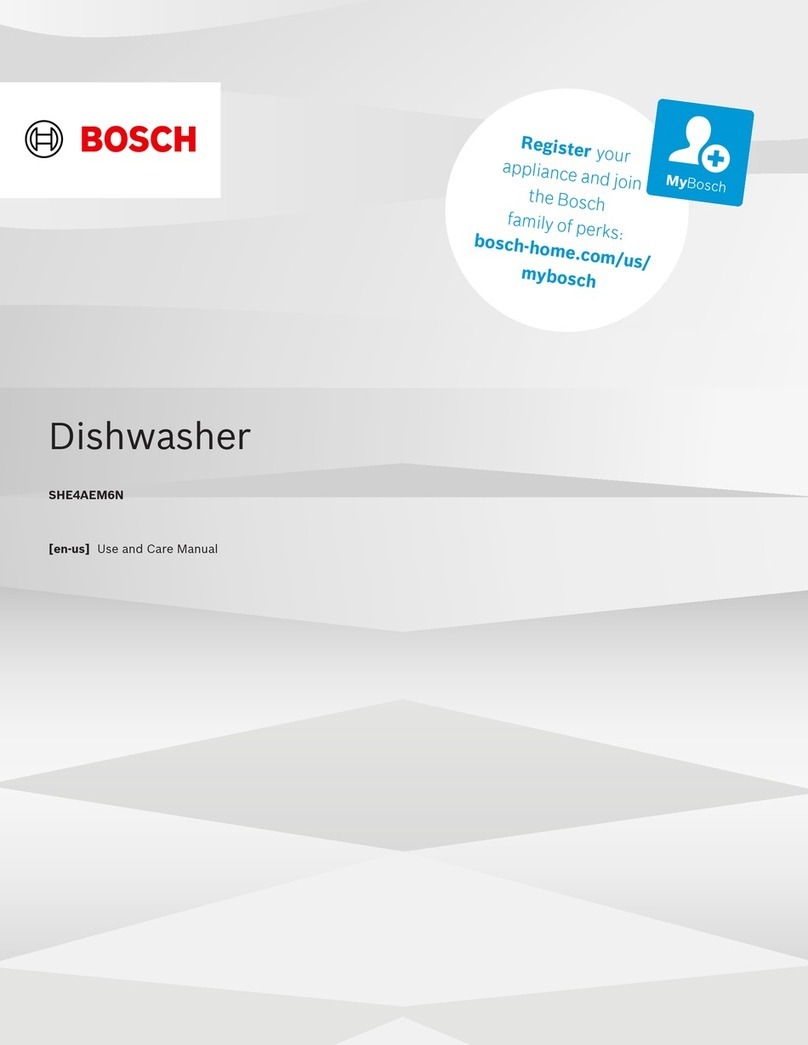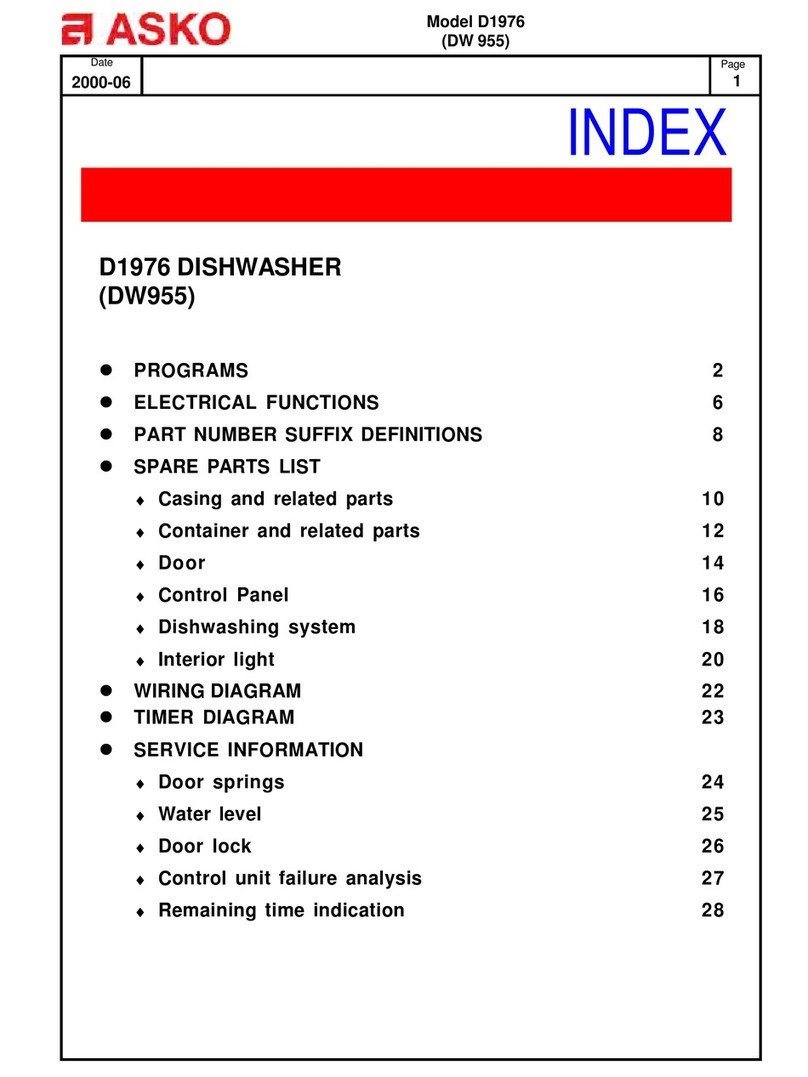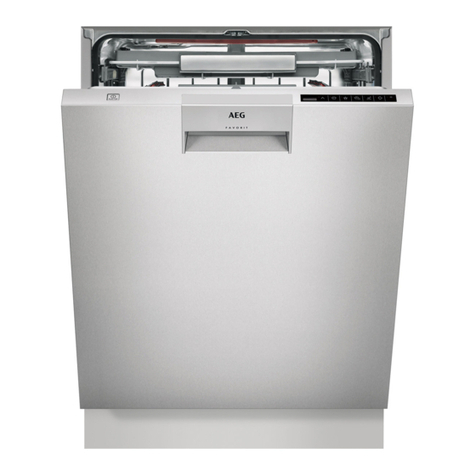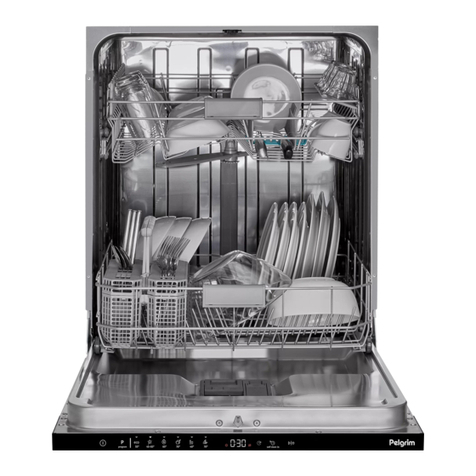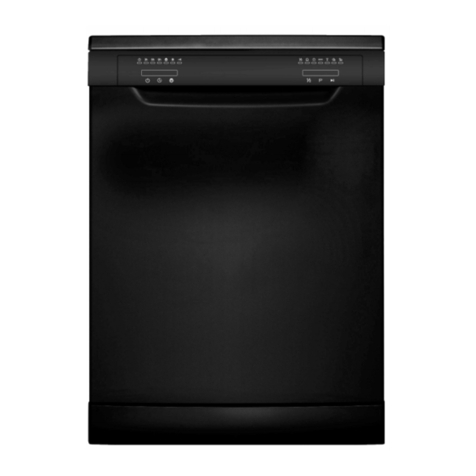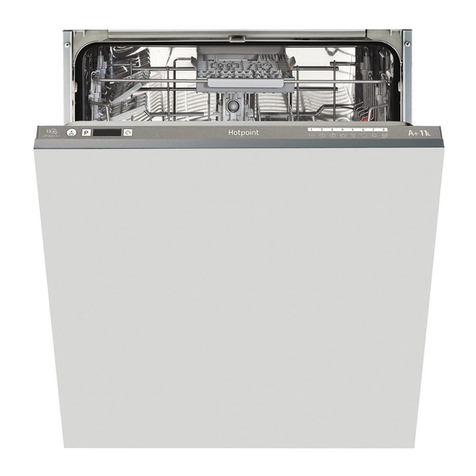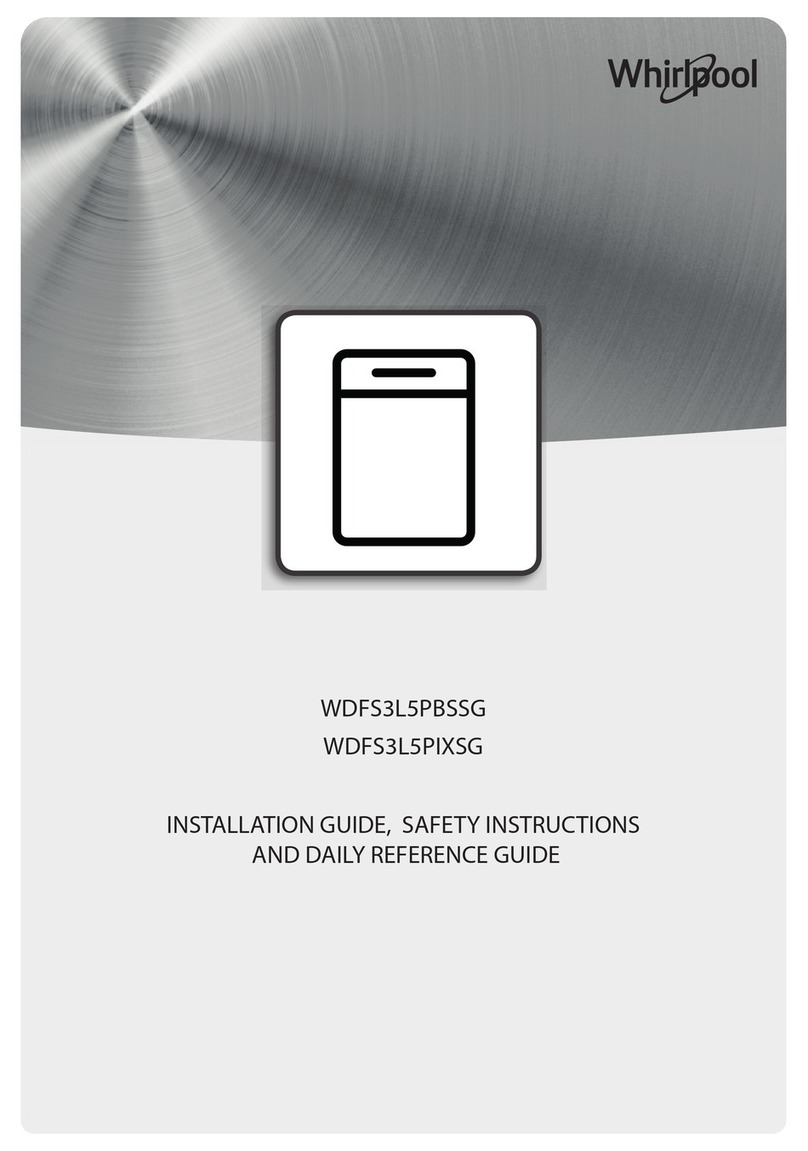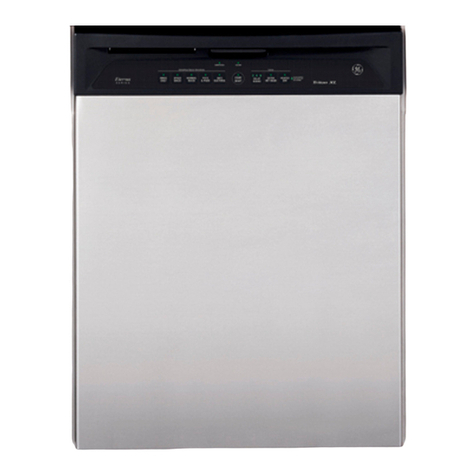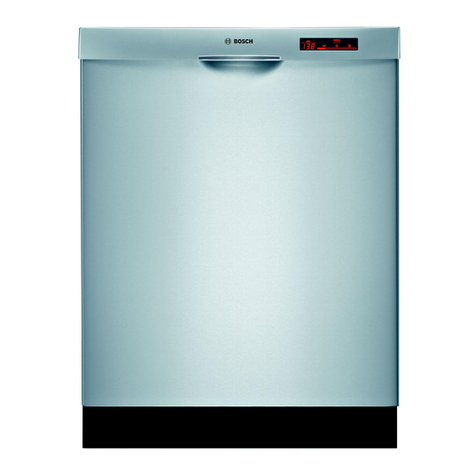St George DWSG50 User manual

Dishwasher
Appliance Operation Manual
INCLUDING INSTALLATION
DWSG50 - Semi Integrated

WELCOME TO ST GEORGE
St George is a proud Australian
company with a heritage of
innovation and quality.
Our success extends to
domestic and overseas markets,
confirming our reputation at the
forefront of appliance excellence.
The elegant simplicity and high
performance features of
St George designs, will
remain contemporary in
many years to come.

Page
Safety advice 4
Installation 5-6
Adding rinse aid 6
Loading the dishwasher 7
Adding washing detergent 8
Choice of programmes 9
Glassware, Pots and Silverware 10
Cutlery, China and Woodware 10
Technical characteristics 11
Installation 11
Instructions for cleaning and maintenance 12
Troubleshooting 13
Illustrations 1 - 4 14
Illustrations 5 - 14 15-16
Warranty and Service
BEFORE READING THESE EXPLANATIONS, CONSULT THE ILLUSTRATIONS
ON THE PAGES 14-16 OF THIS INSTRUCTION MANUAL
——————
CONTENTS

• 4 •
Please read the instructions in this booklet
carefully. You will find instructions necessary for
security, installation and using your machine as
well as the guarantees. We advise you to keep
the booklet and pass it on if you sell the
machine.
We cannot accept responsibility if the
instructions below are not followed :
- Please destroy the packaging in an
appropriate way and in compliance with
environmental protection legislation.
- If the machine is visibly damaged, do not
connect it and contact your dealer.
- It should be placed in a frost-free area. In case
of frost, the hydraulic systems may be
damaged.
- The water supply and evacuation pipes must
be connected according to instructions.
Incorrect connections may cause damage.
- To ensure proper stability, built-in machines
should be installed below a continuous work
surface fixed to the adjoining cabinets.
- You should not stand or lean on the open
dishwasher door. The machine could tip over
or be damaged.
- The machine is intended to wash dishes and
should not be put to other uses.
- Using solvents to clean or maintain your
machine is highly unsuitable.
You should store dishwasher products as well as
other cleaning products out of the reach of
children. These products have a corrosive effect
on the mouth and pharynx if they are
swallowed.
- If the machine malfunctions due to other
causes than those mentioned in this booklet,
disconnect the machine (remove the plug) or
break the circuit concerned and contact our
after-sales service.
- The machine complies with applicable safety
regulations. Any repairs should only be carried
out by qualified technicians. Repairs or
changes that do not conform may be
dangerous for the user. In case of replacement,
only use original parts.
- Broken machines should be taken to the
closest recycling centre. Destroy the door
closing system so it no longer works (children
may close themselves in whilst playing and
suffocate). Cut the electric cable after having
removed the plug from the socket.
- You are strongly advised to disconnect the
machine after use and turn off the water
supply.
- Do not let children play with the machine or
touch it.
- The water inside the machine is not suitable
for drinking.
- When the machine is running, do not open
the door. This may provoke important steam
leakage or splattering of water.
SAFETY ADVICE

• 5 •
Before you start :
1 . These instructions are intended as a guide
only. It is the responsibility of the Plumber
and Electrician to ensure that each
installation complies with local by-laws.
2 . Connection to cold water is recommended.
3 . When installing the Dishwasher, check that
the drain hose does not become restricted or
kinked.
Levelling : Adjusting the feet (Fig. 4) :
Make sure that the machine is properly upright
and stable. The four feet may be altered, adjust
them if necessary using a wrench or a
screwdriver. Badly adjusted feet may move the
door off centre and make the machine
unstable.
IMPORTANT : Do not connect the dishwasher to
the power or water supply before completing
installation.
If you are installing your dishwasher on carpet,
adjust the feet so that you leave space for air to
circulate underneath the machine.
Fitting your machine into your kitchen :
The building in sizes for the machine are given
in the “technical characteristics” chapter on
page 11.
Plumbing :
. Water Supply (Fig. 2)
a . The water supply to the Dishwasher should
not be less than 12 mm domestic water pipe.
A readily accessible tap must be installed in
the supply pipe.
b . The inlet connection hose supplied is fitted
to a 3/4" BSP male thread, which must have
an adequate sealing face for the washers
supplied.
c . The water supply pressure is to be between
21 kPa (4.0 psi) minimum and 970 kPa
(140 psi) maximum.
If pressure is greater 100 psi, it is recommended
to fit a pressure limiting valve to prevent
damage from rises and increased pressure of
peak demand.
Evacuating waste water (Fig. 3)
Connect the waste pipe
A. Either to the ventilated siphon. The waste
pipe must be free in the siphon and should
be no deeper than 20 cm.
B. Or on the sink siphon. Be careful not to
forget to remove the siphon cover.
Be careful to fix the waste pipe down with a tie
to avoid any flooding. In any case, the end of
the pipe must be between 60 cm and 1 m high.
Avoid folding the pipe when installing.
- Horizontal drain lines should not exceed 5 m
length.
- Ensure that the drain hose is fully extended
and not restricted in any way.
NOTE : Do not connect drain hose directly
to a waste disposal unit as blocking with
food waste will occur.
Connecting to the power supply :
You should use an earthed plug to connect to
the power supply. In case of a direct connection,
the main switch terminal should be at least
3 mm apart.
The electric plug should remain accessible. Do
not use an extension lead or multiple plug.
• We cannot be held responsible for any
incident caused by the machine being badly
earthed.
In any case, the machine must be fitted in
compliance with the applicable regulations in
your state as well as any extra instructions from
the Electricity Company. The machine’s approval
INSTALLATION

• 6 •
and model are indicated on the sticker fixed to
the left-hand side of the door. The machine
must be turned off when connecting to the
electric circuit.
Rinse aid is necessary as it avoids stains on the
dishes and makes drying easier.
IMPORTANT ! Only use products intended for
dishes and NOT detergents intended for hand
washing !
Filling and adjusting the rinse aid container
(Fig. 5-6) :
Put the door in a horizontal position when
filling the container and unscrew the cap in the
door counter clockwise.
Fill to just below the adjusting lever.
If the product overflows on filling, remove the
excess with a sponge to avoid any foam
forming.
If you experience stains or bad drying after
several cycles, you may adjust the dosage using
the selector :
Soft water : level 1 to reduce the dose
Hard water : level 3 to increase it.
A light on the control panel comes on when
you need to add rinse aid.
For child safety :
Dishwashing detergent and rinse aid should be
treated as poisons and stored where they are
not accessible to children.
ADDING RINSE AID
INSTALLATION CONTINUED

• 7 •
For best washing results, be careful before
loading dishes to remove food residue. Any
burned or stuck leftovers should be removed.
Your dishwasher has two baskets for 14 place
settings (162 pieces) according to AS 2007
(Fig. 10 and 12). Always turn the inside of the
dishes towards the bottom. Be sure that no dish
hides others and the spray jet is not obstructed.
Check that the spray arm is free to rotate. No
dish should be higher than the basket.
Lower basket (Fig. 7-9-10)
Place the dishes so that water may circulate
freely and spray all the utensils. (Avoid
attaching and piling dishes up).
This basket is especially intended to hold:
plates, cutlery, dishes, frying pans, saucepans.
Dishes and frying pans can be placed on the
right-hand side or even in the front.
Avoid mixing plates and soup dishes. You
should preferably place same-sized plates
together.
Place soup dishes at the back, in the high pin
area.
Make sure nothing obstructs the rotation of the
lifting arm (saucepan handles, cutlery or large
dishes).
The cutlery baskets are sliding and can be
placed in any area of the lower basket meaning
that you can change the layout according to the
type of dishes you are washing.
Removable grids are adaptable to cutlery
baskets allowing you to arrange cutlery,
especially small spoons, as you wish.
For optimum washing, you can use the
separation grids.
Cutlery (Fig. 8)
• Place handles downwards.
• It is preferable to place small spoons in the
separating grids.
• Avoid washing wooden, bone or hollow
handled cutlery in the machine.
• Separate silverware from other metals using
the separating grid.
Important note : For reasons of safety, we
recommend you place sharp-ended table knives
blade down in the cutlery basket.
Long-bladed cutlery and other sharp utensils
should be placed flat in the upper basket.
Upper basket (Fig. 11-12)
This basket is particularly intended to hold
glasses, cups, ramekins, small salad bowls, bowls,
saucers etc…
Place glasses so that they do not touch and tip
them sufficiently so that they do not retain any
water. Place the hollow end of glasses, cups
and bowls facing downwards. Arrange the
dishes methodologically to gain space (rows of
glass, cups, and bowls).
You can also stack cups, ladles, etc. on the racks.
LOADING THE DISHWASHER

• 8 •
The washing product container has been placed
in front of the upper basket to make the
machine easier to fill. This means that you can
load the dishwashing powder without bending
down or completely opening the door. Use
washing products specifically designed for
dishwashers, either tablets, powder or liquid
detergent.
Before running a programme :
• Put the tablet in the outside compartment.
OR
• Pull the distributor out to fill with powder or
liquid. Minimum and maximum levels are
marked on the inside of the distributor and
represent approximately 10-25 grams or 2-5
teaspoons. Amount required to be used for
each load may vary according to the
conditions such as dirtiness of the dishes,
water hardness and detergent type. However
in most cases 10 grams (2 teaspoons) of
dishwashing powder will be sufficient.
Close the distributor.
See the manufacturers’ recommendations on
the packet as well as the advice for use below.
ADDING WASHING DETERGENT
For child safety
Warning - Dishwasher detergents are strongly alkaline. They can be extremely dangerous if
swallowed. Avoid contact with skin and eyes and keep chidren away from the dishwasher when the
door is open.
Check that the detergent receptacle is empty after completion of the wash cycle !
tablet
powder or liquid

• 9 •
For information purposes :
Duration Water Electricity
_________________________________________________________________________
1 - Prewash 5 mins 5 L 0.1 kWh
2 - Wash 60 °C 80 mins 24 L 1.65 kWh
2 + Eco Wash 50 °C 74 mins 24 L 1.47 kWh
CHOICE OF PROGRAMMES
1 = Prewash :
Very short cycle, without detergent, rinses dishes before
washing the next day or the day after.
2 + Eco = Wash 50 °C :
Recommended for normally dirty dishes (daily stains).
2 = Wash 60 °C :
Recommended for very dirty or greasy dishes
(difficult stains : fat, sauce, cooking or frying stains...).
➀
Programme button
Option button
Start button
Indicator lights :
• Rinse Aid Required - Refer Page 6
• Wash in Progress : means that the cycle timer is in progress.
• Time Remaining : means that 15 mins remains before the end of the cycle.
➀
➁
➂
➃
➃
➂➁

• 10 •
Glassware
Most glassware is dishwasher safe. We do not
recommend washing crystal items in the
dishwasher, as crystal is not dishwasher safe.
Pots and Saucepans
쐽Pots and saucepans can be washed in the
dishwasher. Scrape off food scraps and put
items in the baskets upside-down.
쐽Stainless steel can be washed in the
dishwasher.
쐽As when hand washed, aluminium is dulled
by being washed in the dishwasher.
Silverware
쐽All silverware should be rinsed immediately
after use to prevent discolouration caused by
some foods.
The “Prewash” programme is useful for this
situation.
쐽Old silverware and hollow handle knives with
adhesives securing the handles should be
washed by hand.
GLASSWARE, POTS AND SILVERWARE
Cutlery
쐽Stainless steel and silver should not be
allowed to come into contact with each
other, as this can stain the silver.
쐽Remove sterling and silver plated cutlery
from the dishwasher and hand dry it
immediately after the programme has
finished.
쐽Wooden, bone and plastic handles can be
sensitive to higher water temperatures. The
appearance of these items may change over
time if washed in the dishwasher.
Decorated China and Tableware
쐽Most current china patterns are dishwasher
safe. However, we advise checking with their
manufacturer.
쐽Older items with the design over the glaze,
ie. gold rims and hand-painted China may be
more sensitive to machine washing. If in
doubt, wash these items by hand.
Woodware
Generally wooden items are sensitive to heat
and water.
Regular use in the diswasher may alter their
appearence. We suggest you wash wooden
items by hand.
Remember, if in doubt about any aspect
concerning materials washed in the dishwasher,
follow manufacturer's instructions or use a pre-
wash.
CUTLERY, CHINA AND WOODWARE

• 11 •
Voltage : 230-240 V – 50 Hz – Fuses : 10 A
Power : 2150-2300 W
Capacity : 14 place settings
Water pressure : 3 psi/21 kPa min
100 psi/690 kPa max
Water evacuation pipe height : 60 cm - 1 m
TECHNICAL CHARACTERISTICS
INSTALLATION
COMPARATIVE TESTS ACCORDING TO : AS/NZS 2007 : 98
Programme “2 + Eco Wash 50 °C ”
• Rinse aid dispenser setting on : 3
• Quantity of washing product : 40 g.
• For the determination of Drying Index the door of the dishwasher was opened approximately
240 mm at the end of the programme for 30 minutes.
Building the free-standing machine in
If you install the dishwasher built-in under an existing worktop, you must attach it with the front
bracket to a fixed worktop. If installing in this way, proceed as follows:
- Remove the worktop by unscrewing the 2 screws under the edge of the upper plate.
- Fit the dishwasher into its housing.
- Adjust the height of the feet if necessary (fig. 4).
- Use two screws to fasten the front bracket to the kitchen worktop, so as to make your dishwasher
fast.
For safety reasons St George recommends that your dishwasher is not installed directly
below a cooktop. If installation is carried out in this manner your warranty may be void.
NOTE
:
These measurements are
shown without worktop fitted. If installing
with worktop fitted :
1 - To over all height add 32mm
2 - To overall width add 4mm
3 - Overall depth of worktop from rear
to front comers = 581mm
4 - Overall depth of worktop from rear
to centre front 600mm

• 12 •
INSTRUCTIONS FOR CLEANING AND MAINTENANCE
• Your dishwasher comes with a self-cleaning
pulse filter that constantly filters small
particles of dirt trapped in the washing bath.
The filter and the main filter cannot be
dismantled as the cleaning arm constantly
cleans them.
NEVERTHELESS:
- Regularly clean the waste trap. To do this:
Fig. 14 ➀➀Pull the waste trap handle upwards.
- Clean the drainage outlet (3 to 4 times per
annum). To do this:
Fig. 14 ➁➁Remove the drainage outlet by
pushing the tab backwards, and then pulling
upwards.
- Remove residue using a brush.
- Clean under running water.
- Return the unit to its housing taking care that
it is well engaged.
Clean as necessary
• Underneath the filters, around the door and
the door joint with a damp sponge to remove
any deposit.
• Use only soap and water for the body and
control panel.
• Do not clean with abrasive powders, scouring
pads, spirit-based products or solvents.
Preferably use a cloth or a sponge.
• If you have a stainless steel door you may use
products adapted for stainless steel. See the
manufacturer’s instructions for advice on their
use.
Every year
To maintain your machine in perfect working
order you should clean it once or twice a year.
Run on “Wash 60 °C” programme with the
machine empty and a special dishwasher
cleaning product available from any reputable
dealer.
Prolonged period of non-use
Clean your machine completely then unplug the
electricity supply and close the water tap.

• 13 •
TROUBLESHOOTING
If you have problems not covered by these remarks, contact St George After Sales Service on phone
1300 305 366.
Causes
- Is it plugged in ?
- Is the door properly closed ?
- Is the water connected ?
- Programme choice. Choose the programme best adapted
to the type of wash
- Make sure nothing is blocking the circulation of the water
- Check the dishes are properly arranged.
- Only use specially designed washing products
- Check the waste well, filters, arms, joints and door rim are
clean
- Clean the filter
- Check that the washing arm can freely rotate
- Increase the dose of washing product
- Use a new packet of washing product
- Choose a better adapted programme
- Check it is limescale (clean with vinegar). If yes :
- Check the hardness of the water
Too soft water is aggressive for glasses.
- Check the hardness of the water
- Remove food residue immediately after use
- Separate silverware from other metals
- Choose detergent recommended for silverware
- Use knives suitable for dishwashers
- Remove the siphon stop valve
- Check the drain pipe is not bent or crushed
- Check to see if you have moved your dishwasher and
tipped it backwards. To restart the pump, unhook the
draining rod, lay it on the floor at the end of a basin,
draining should restart. Then turn off the “Start/Stop”
button, put the draining rod back and restart your
programme.
This machine complies with all applicable safety standards.
Any repairs should be carried out by a qualified technician.
Repairs carried out by unqualified technicians may be
dangerous for the user.
Problems
The dishwasher will not start
The dishes are not properly washed
Greasy stains
Limescale deposits on the dishes
The dishes are dull
Blackened or marked silverware
Traces of rust on knife blades
The dishwasher does not empty

• 14 •
ILLUSTRATIONS
1. Work top
2. Upper basket
3. Washing detergent distributor
4. Self-cleaning microfilter
5. Rating plate
6. Lower spray arm
7. Main filter
8. Waste trap
9. Rinse aid distributor
The photograph above, with lower basket removed, shows you the main parts
described in this instruction manual.
1
234
8
9
2
3
4
5
6
7
1

• 15 •
11
56
9
7
➀➀
➁➁
14

• 16 •
12
10
knives
knives
Teaspoons Soup spoons
8
SpoonsForks
COMPARATIVE TESTS ACCORDING TO : AS/NZS 2007 : 98
Programme “2 + Eco Wash 50 °C ”
• Rinse aid dispenser setting on : 3
• Quantity of washing product : 40 g.
• For the determination of Drying Index the door of the dishwasher was opened approximately
240 mm at the end of the programme for 30 minutes.
IMPORTANT : To ensure optimal
washing and drying efficiency it is
important not to overload the
dishwasher racks.

WARRANTY AND SERVICE
DOMESTIC WARRANTY - FULL FIVE YEAR WARRANTY
In addition to all statutory rights which you, the Consumer, have under the relevant laws in respect
of this appliance, during the first five years of ownership as the original purchaser of this
St George appliance, we guarantee that any fault caused by faulty material or workmanship
becoming apparent will be rectified free of charge for parts and labour, provided that all service is
performed during normal working hours by St George or their designated Agents. Where the
appliance is installed outside the normal servicing area of the above, the Purchaser must pay for
the cost of transporting the appliance to and from the Agent or the Agent’s travelling cost to and
from the Purchaser’s home.
COMMERCIAL WARRANTY - ONE YEAR WARRANTY
When this appliance is installed in a commercial application, you, the Consumer, have under the
relevant laws in respect of this appliance, during your first one year of ownership as the original
purchaser of this St George appliance, we guarantee that any fault caused by faulty material or
workmanship becoming apparent, will be rectified free of charge for parts and labour, provided that
all service is performed during normal working hours by St George or their designated Agents.
Where the appliance is installed outside the normal servicing area of the above, the Purchaser
must pay for the cost of transporting the appliance to and from the Agent or the Agent’s travelling
cost to and from the Purchaser’s home.
WHAT THESE WARRANTIES DO NOT COVER
We are not responsible for any damage or malfunction unless caused by a defect in material or
workmanship. This includes but is not limited to abuse, misuse, improper installation and
transportation damage. We are not responsible for any consequential damages from any
malfunction.
The Consumer must make the appliance available for servicing and shall bear any costs incurred
for any de-installation and/or re-installation required to make the appliance available for servicing.
St George is not liable for any consequential damage incurred during de-installation or re-
installation.
WARRANTY DOES NOT COVER REPLACEMENT OF LIGHT
GLOBES OR GLASS BREAKAGE DUE TO IMPACT
In case of fractured glass do not use your appliance.
WARRANTY REGISTRATION
Please complete warranty details below. Please retain together with your proof of purchase document.
These documents will need to be viewed by our Service Representative should you request in warranty
service.
SERVICE ASSISTANCE
To assist you when phoning our After Sales Service number to arrange a service call please complete
the following details and have them ready when you call.
Model Number_____________________________Date of purchase____________________________
St George Store purchased from_________________________Date of installation ________________
ST GEORGE AFTER SALES SERVICE
1300 305 366

A Tradition of Excellence
1300 305 366
Table of contents

